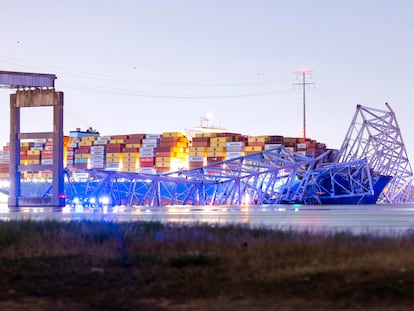Collapse of Baltimore bridge: Graphs and maps to understand what happened
A 300-meter container ship with propulsion problems deviated from its course and knocked down a city icon
On Tuesday, the largest bridge in Baltimore collapsed in a matter of seconds after being hit by a container ship. A group of maintenance workers were working on the bridge at the time of the impact. The ship — named Dali — left the port, but minutes later, the crew informed port authorities that there were problems with the ship’s propulsion system and that the bridge was in their path, which allowed authorities to cut off road traffic before the crash.
A nearby webcam broadcast the collision live. The ship enters into view at 1:23 a.m. The electrical and propulsion problems that the crew had warned about can be observed, giving insight into what happened moments before the collision.
The Dali — which was 48 meters wide and almost 300 meters long — deviated from its course moments before passing under the structure. The span of the bridge, that is, the distance between the pillars that support the metal construction, was about 366 meters. The clearance — the distance between the water and the bottom point of the bridge — exceeds 56 meters, so there was more than enough space for a ship of the Dali’s dimensions to pass through.
The ship’s collision with one of the bridge’s pillars was enough to make a portion of the bridge collapse. The Dali is a vessel that can transport up to 10,000 containers. An initial estimate from an engineer, who spoke to Spain’s EFE news agency, suggested that there may have been 150,000 tons in motion — the equivalent of 1,500 buses — traveling at around 9 miles per hour.
Baltimore woke up to images of its most iconic bridge severed in half and to the news that emergency services had rescued two people and were searching for another seven missing people (a figure that would later be reduced to six, who are presumed dead). The 820-meter span of the four-lane bridge, which is used by 31,000 vehicles per day, sunk into the Patapsco River.
The port of Baltimore is the 16th largest in the United States by activity, where $74 billion-worth of goods entered the country last year. While it is not one of the largest on the East Coast — it receives cargo that is 10 times smaller than the port of New York — it is, however, the American leader in handling cargoes of various types of products, such as carloads (about 750,000 vehicles passed through the port in 2023), salt and sugar. It is also the second-largest port in the U.S. for coal exports.
Creditos
Sign up for our weekly newsletter to get more English-language news coverage from EL PAÍS USA Edition

